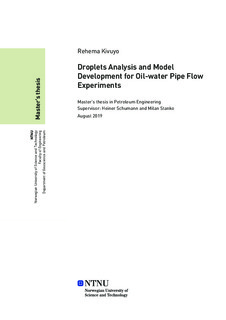| dc.description.abstract | Among other things one of the major challenges in production of crude oil is the associated water that tugs along with oil. The results of the simultaneous production of oil and water is the formation of different flow regimes. These flow regimes can range from as simple as
totally separated phases to totally complicated regimes like mixed (dispersed) flow. Different flow regimes are associated with different potential pressure drops over the production line. Precise prediction of the pressure drop along the line is of vital significance during both the design and production phase.The advancement of technology in the Petroleum industry, have been of much input to the industry in development of numerous commercial flow simulators. Unfortunately, these flow simulators have only been accurate for some types of flow. The prediction of flow regimes involving oil-water dispersions is rather unreliable and requires further model studies and improvements. The correct representation of rather complex flow regimes in a simplified way is not always clear. While most models are able to handle the extremes of stratified and fully dispersed flow, the in-between situation of partly or inhomogeneously dispersed flow is often not considered.
This thesis has thus dedicated in two parts. First part is the modelling of the pressure gradient in the two phase stratified flow and the three layers flow. The three layers flow involves two continuous oil and water layers which are separated by dense packed layer of droplets in the middle. The three layers model was extended from the two fluid model by an addition of a homogeneous dispersed layer between the oil and water continuous layers. Both models were Implemented in MATLAB. The models were then tested with the provided data from two different experiments performed in SINTEF laboratory hall. The experiments were conducted in a 220m test section with 4" diameter at different times. The first experiment was conducted with low oil viscosity of 1.43 cp and the later with a medium oil viscosity of 35 cp. The provided data comprised of pressure drops, video recordings, phase fraction
profiles and in-situ droplet measurements at different positions along the pipe. The two fluid model resulted in good predictions of pressure gradients with the predictions that were very close to the experimental measurements. The deviation of modeling predictions and experimental measurements resulted an average absolute error of 1.78% and average relative error of 2.35%. These results were improved by the use of hydraulic diameter in the modeling which reduced the average absolute error to 1.64% and average relative error of 2.14%. The three layers model predicted the pressure drop for very few among the identified three layers flow patterns. The prediction results for such few patterns were good and The model looked okay. The deviation of the model and the measured pressure gradient
resulted an average absolute error of 1.02% and average relative error of 1.27%. The three layers model was not improved when the hydraulic diameter was used but performed well when the pipe diameter was used instead. For experiments which were identified to have three layers flow patterns but were not well predicted by the the model, It was proposed that the large deviation in the input phase fractions and the insitu phase fractions could be the reason to such deviations. Including the effect of slip between the phases was suggested to be a measure to improve these predictions in the three layers flow pattern.
The second part of the report involved the analysis of the droplets sizes from the experiments with medium viscosity(35cp) oil. Flowrate and the pressure drop over a choke valve at the test section inlet were varied to simulate flow disturbance so that at different flow conditions, the droplets behaviours can be captured and interpreted. The comparison was then made between the analysis of experiments with low oil viscosity (were previously analyzed in the Project report) and the medium viscosity oil. Droplets from medium viscosity oil, were found hard to coalesce and to settle at the bottom of pipe during the flow unlike when the oil viscosities were low. The two oils also composed different types and different concentrations of surfactant which was also a contributing factor to the the less development of droplets in the medium oil viscosity experiments. | |
